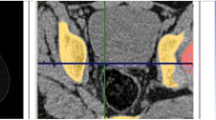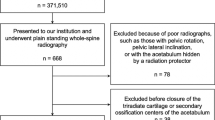Abstract
Purpose
Acetabular morphology is an important predictor of the severity of osteoarthrosis and survival of hip prostheses but there is limited data on the normal range of acetabular measurements on plain radiographs. The aim of this project was to determine the statistically normal ranges of acetabular inclination (AI) and center-edge angle (CEA).
Method
One hundred coronal CT localizers (50 men and 50 women aged 20–30 years) were included in this study. All the patients underwent CT examination for thoracic or intra-abdominal indications. Patients with pelvic disease, fractures, history of serious trauma, or previous pelvic surgery were excluded. One pair of independent observers measured the AI and pelvic tilt (PT), and a further pair measured the center-edge angle (CEA), using electronic calipers on a high-resolution PACS workstation.
Results
AI and CEA measurements were obtained for 200 hips. There was very good intra-class correlation between the observers (r = 0.7–0.8). The mean AI was 38.8° (2SD 32.1–45.5°). That in men was 38.0° (2 SD 31.8–44.1°) and 39.6° (2 SD 32.7–46.8°) in women, which was statistically significantly different (p < 0.001). The mean CEA measurement for all patients was 36.3° (SD 13.8°), for men 37.7° (SD 10.8°) and for women 34.9° (SD 11.4°) with a statistically significant gender difference (p < 0.001). The mean pelvic tilt measurement (sacro-coccygeal-pubic symphysis) was 38.3 mm (2 SD 18.3–58.3 mm) with a significant gender difference (p < 0.001).
Conclusions
The results of this study define reference ranges of two common measures of acetabular morphology and confirm statistically significant differences between men and women.










Similar content being viewed by others
References
Murray DW. The definition and measurement of acetabular orientation. J Bone Jt Surg Br. 1993;75(2):228–32.
Giori NJ, Trousdale RT. Acetabular retroversion is associated with osteoarthritis of the hip. Clin Orthop Relat Res. 2003;417:263–9.
Tönnis D, Heinecke A. Acetabular and femoral anteversion: relationship with osteoarthritis of the hip. J Bone Jt Surg Am. 1999;81(12):1747–70.
Wagner S, Hofstetter W, Chiquet M, Mainil-Varlet P, Stauffer E, Ganz R, et al. Early osteoarthritic changes of human femoral head cartilage subsequent to femoro-acetabular impingement. Osteoarthritis and Cartilage / OARS. 2003;11(7):508–18.
Leunig M, Beck M, Dora C, Ganz R. Femoroacetabular impingement: trigger for the development of coxarthrosis. Orthopade. 2006;35(1):77–84.
Ganz R, Leunig M, Leunig-Ganz K, Harris WH. The etiology of osteoarthritis of the hip: an integrated mechanical concept. Clin Orthop Relat Res. 2008;466(2):264–72.
Steppacher SD, Tannast M, Werlen S, Siebenrock KA. Femoral morphology differs between deficient and excessive acetabular coverage. Clin Orthop Relat Res. 2008;466(4):782–90.
Vossinakis IC, Georgiades G, Kafidas D, Hartofilakidis G. Unilateral hip osteoarthritis: can we predict the outcome of the other hip? Skeletal Radiol. 2008;37(10):911–6.
Tannast M, Langlotz U, Siebenrock KA, Wiese M, Bernsmann K, Langlotz F. Anatomic referencing of cup orientation in total hip arthroplasty. Clin Orthop Relat Res. 2005;436:144–50.
Haenle M, Heitner A, Mittelmeier W, Barbano R, Scholz R, Steinhauser E, et al. Assessment of cup position from plain radiographs: impact of pelvic tilting. Surg Radiol Anat. 2007;29(1):29–35.
Sharp IK. Acetabular dysplasia: the acetabular angle. J Bone Jt Surg Br. 1961;43(2):268.
Wiberg G. Studies on dysplastic acetabula and congenital subluxation of the hip joint. Acta Chir Scand. 1939;83:1–132.
Lewinnek GE, Lewis JL, Tarr R, Compere CL, Zimmerman JR. Dislocations after total hip-replacement arthroplasties. J Bone Jt Surg Am. 1978;60(2):217–20.
Siebenrock KA, Kalbermatten DF, Ganz R. Effect of pelvic tilt on acetabular retroversion: a study of pelves from cadavers. Clin Orthop Relat Res. 2003;407:241–8.
Nagao Y, Aohi H, Ishii SJ, Masuda T, Beppu M. Radiographic method to measure the inclination angle of the acetabulum. J Orthop Sci Jap Orthop Assoc. 2008;13(1):62–71.
Kalteis TA, Handel M, Herbst B, Grifka J, Renkawitz T. In vitro investigation of the influence of pelvic tilt on acetabular cup alignment. J Arthroplasty. 2009;24(1):152–7.
Stulberg SD, Harris WH. 1974. Acetabular dysplasia and development of osteoarthritis of the hip. In The Hip: Proceeding of the Second Open Scientific Meeting of the Hip Society. St Louis, Mo: CV Mosby, pp. 83–93
Armbuster TG, Guerra Jr J, Resnick D, Goergen TG, Feingold ML, Niwayama G, et al. The adult hip: an anatomic study. Part I: the bony landmarks. Radiology. 1978;128(1):1–10.
Lembeck B, Mueller O, Reize P, Wuelker N. Pelvic tilt makes acetabular cup navigation inaccurate. Acta Orthop. 2005;76(4):517–23.
Tannast M, Murphy SB, Langlotz F, Anderson SE, Siebenrock KA. Estimation of pelvic tilt on anteroposterior X-rays–a comparison of six parameters. Skeletal Radiol. 2006;35(3):149–55.
Tönnis D. Normal values of the hip joint for the evaluation of X-rays in children and adults. Clin Orthop. 1976;119:39–47.
McGraw K, Wong SP. Forming inferences about some intraclass correlation coefficients. Psychol Meth. 1996;1(1):30–46.
Altman DG, 1990. Practical Statistics for Medical Research 1st ed., Chapman and Hall/CRC
Kojima A, Nakagawa T, Tohkura A. Simulation of acetabular coverage of femoral head using anteroposterior pelvic radiographs. Arch Orthop Trauma Surg. 1998;117(6–7):330–6.
Sandring S, Healy J, Johnson D, Williams A, Ellis H (eds.) 2004. Pelvic girdle and lower limb. In Gray’s Anatomy: The Anatomical Basis of Clinical Practice. 39th Ed. Churchill Livingstone, p 1430
Pederson DR, Lamb CA, Dolan MA, Ralston BS, Weinstein SL, Morcuende JA. Radiographic measurements in developmental dysplasia of the hip: reliability and validity of a digitizing program. J Ped Orthop. 2004;24(2):156–60.
Richards PJ, Pattison JM, Belcher J, DeCann RW, Anderson S, Wynn-Jones C. A new tilt on pelvic radiographs: a pilot study. Skeletal Radiol. 2009;38(2):113–22.
Tannast M, Zheng G, Anderegg C, Burckhardt K, Langlotz F, Ganz R, et al. Tilt and rotation correction of acetabular version on pelvic radiographs. Clin Orthop Relat Res. 2005;438:182–90.
Anda S, Svenningsen S, Grontvedt T, Benum P. Pelvic inclination and spatial orientation of the acetabulum. A radiographic, computed tomographic and clinical investigation. Acta Radiol. 1990;31(4):389–94.
Sanders G, Starvakas P. A technique for measuring pelvic tilt. Phys Ther. 1981;61(1):49–50.
Nishihara S, Sugano N, Nishii T, Ohzono K, Yoshikawa H. Measurements of pelvic flexion angle using three-dimensional computed tomography. Clin Orthop Relat Res. 2003;411:140–51.
Crawford MB, Toms AP, Shepstone L. Defining normal vertebral angulation at the thoracolumbar junction. AJR Am J Roentgenol. 2009;193(1):W33–7.
Conflict of interest
None.
Author information
Authors and Affiliations
Corresponding author
Rights and permissions
About this article
Cite this article
Fowkes, L.A., Petridou, E., Zagorski, C. et al. Defining a reference range of acetabular inclination and center-edge angle of the hip in asymptomatic individuals. Skeletal Radiol 40, 1427–1434 (2011). https://doi.org/10.1007/s00256-011-1109-3
Received:
Revised:
Accepted:
Published:
Issue Date:
DOI: https://doi.org/10.1007/s00256-011-1109-3




